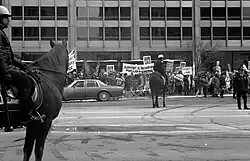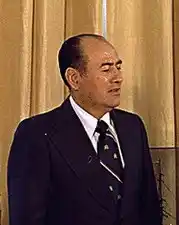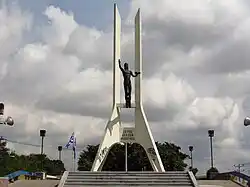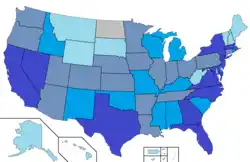
The Salvadoran Civil War was a conflict that occurred in El Salvador in Central America between October 1979 and January 1992. The war came about owing to historical divisions within El Salvadoran society, namely high levels of social inequality between the poor masses and a small elite that had grown rich on the back of the production of cash crops like coffee since the late nineteenth century. It broke out in 1979 when the far-left Farabundo Martí National Liberation Front (FMLN) initiated a guerilla war against the right-wing government. The conflict quickly became a front in the Cold War, with the El Salvadoran government backed by the United States and the FMLN supported by the Soviet Union and Fidel Castro’s Cuba. It was marked by extensive atrocities, primarily committed by the government. It only came to an end once the Cold War had concluded. Approximately 75,000 people lost their lives and one million were displaced. Over one million Salvadorans are understood to have left their small country, creating a Salvadoran diaspora. Hence, many people outside of El Salvador today can trace their family roots back to people who left the country during the era of the civil war.[1]
Research your ancestors on MyHeritage
Salvadoran Civil War chronology of eventsSalvadoran Civil War chronology of events
El Salvador has had a tortured history. After the Spanish Empire began to collapse in the Americas in the early nineteenth century, the region was briefly part of the First Mexican Empire. Thereafter it went through various iterations as an independent country and as a constituent part of efforts to form a unified Central American state, notably the Federal Republic of Central America between 1823 and 1840.[2] Between the mid-nineteenth and the mid-twentieth centuries it was ruled by various military and authoritarian figures. Throughout a small elite of wealthy landowners who produced coffee and other cash crops benefited from the fractious political landscape and alliances with the United States. However, as early as the 1930s, a communist movement emerged in response to La Matanza, ‘The Massacre’, violence against the common Salvadoran people by the government. This sought to redress El Salvador’s endemic inequality and engage in significant wealth redistribution.[3]

By the 1960s there were numerous communist movements in El Salvador, some supported and inspired by the communists that had led the Cuban Revolution in the 1950s. These were engaged in low-level insurgency violence against the government for many years before the outbreak of the Salvadoran Civil War in 1979, but it was in the latter year that this boiled over into a major struggle following a coup d’état that saw President Carlos Humberto Romero overthrown by a military junta. The various left-wing and communist movements joined together to form the Farabundo Martí National Liberation Front (FMLN) in 1980 and wage war directly against the military junta.[4]
The civil war, which is usually identified as beginning with the coup d’état on the 15th of October 1979, would last for nearly twelve and a half years. As it had many other military juntas in South America during the 1970s and 1980s as a result of the Cold War tensions across Latin America, the government of the United States supported the junta in the conflict, fearing that El Salvador would fall into the Soviet camp and provide a new ally for Fidel Castro’s Cuba in the region. The FMLN was supported by the Soviets and the Cubans. It was, in many respects, a low intensity war, with the leftists, for instance, never having much more than 10,000 soldiers in arms at any one time. But it was a bitter struggle all the same, one marked by civilian atrocities on both sides, though international observers eventually concluded that the government was responsible for over 80% of these.[5]

The war did not end in a decisive victory for either side. Instead both sides simply decided to come to the negotiating table once the Cold War drew to a close gradually between 1989 and 1991. The Chapultepec Peace Accords were signed in Mexico City on the 16th of January 1992. The agreement provided for the demobilization of the FMLN guerilla armies and the transition to a democratic government. A ceasefire was imposed and international observers appointed. Not all provisions were successfully implemented in the years that followed, but it was broadly successful and El Salvador transitioned to a democracy, though hardly a stable one, as it has faced new challenges in the shape of endemic gang violence, much of which stems from the civil war era.[6]
Migration associated with the Salvadoran Civil WarMigration associated with the Salvadoran Civil War
The Salvadoran Civil War set off a wave of migration in the country which continued through the twelve and a half years of the conflict and beyond. It has been estimated that upwards of two million people were displaced by the fighting, some internally, though a good many migrated away from El Salvador altogether. Of those that left the country, the vast majority headed north for Mexico with the ultimate goal of reaching the United States. This contributed a half a million people to the Salvadoran American community, which in the pre-war period was relatively small. This flow of Salvadorans north to the United States has continued in the decades since the civil war as the violence which gripped El Salvador in the 1980s has continued in different formats long after the original conflict ended. In the 2000s, Salvadorans constituted one of the largest migrant groups arriving to the US.[7]
Demographic impact of the Salvadoran Civil WarDemographic impact of the Salvadoran Civil War

An estimated 75,000 people lost their lives in the civil war, a high figure for a small country. Curiously, though, the population of El Salvador continued to grow steadily during the 1980s. Instead the greater demographic impact has been caused by the endemic violence which followed in the 1990s, 2000s and 2010s and El Salvador’s population growth stalled during these decades. Abroad the greatest demographic impact of the Salvadoran Civil War has been felt in the United States. While there was already a Salvadoran American community in the 1970s, it was small. The arrival of half a million Salvadorans during the civil war era and hundreds of thousands more Salvadorans every decade since has seen the Salvadoran American community grow to some two and a half million people, making it the third largest Hispanic community in the US in terms of country of ancestry. Of these, approximately one-in-three live in California, with large Salvadoran communities also in Nevada, Texas, Florida and New York. As such many people in the US today can trace their genealogical roots to El Salvador and the changes that occurred there in the civil war era.[8]
See alsoSee also
Explore more about the Salvadoran Civil WarExplore more about the Salvadoran Civil War
- El Salvador, Baptisms, 1750-1940 records collection on MyHeritage
- El Salvador, Civil Registration, 1815-1910 records collection on MyHeritage
- El Salvador, Marriages, 1810-1930 records collection on MyHeritage
References
- ↑ https://cja.org/where-we-work/el-salvador/
- ↑ https://www.oxfordreference.com/display/10.1093/acref/9780191905636.001.0001/acref-9780191905636-e-11443
- ↑ https://www.zinnedproject.org/news/tdih/la-matanza
- ↑ Dermot Keogh, ‘The Myth of the Liberal Coup: The United States and the 15 October 1979 Coup in El Salvador’, in Millennium: Journal of International Studies, Vol. 13, No. 2 (June, 1984), pp. 153–183.
- ↑ https://cja.org/where-we-work/el-salvador/
- ↑ https://peacemaker.un.org/elsalvador-chapultepec92
- ↑ https://www.migrationpolicy.org/article/salvadoran-immigrants-united-states-2008
- ↑ https://www.pewresearch.org/short-reads/2023/09/22/key-facts-about-us-latinos-for-national-hispanic-heritage-month/

